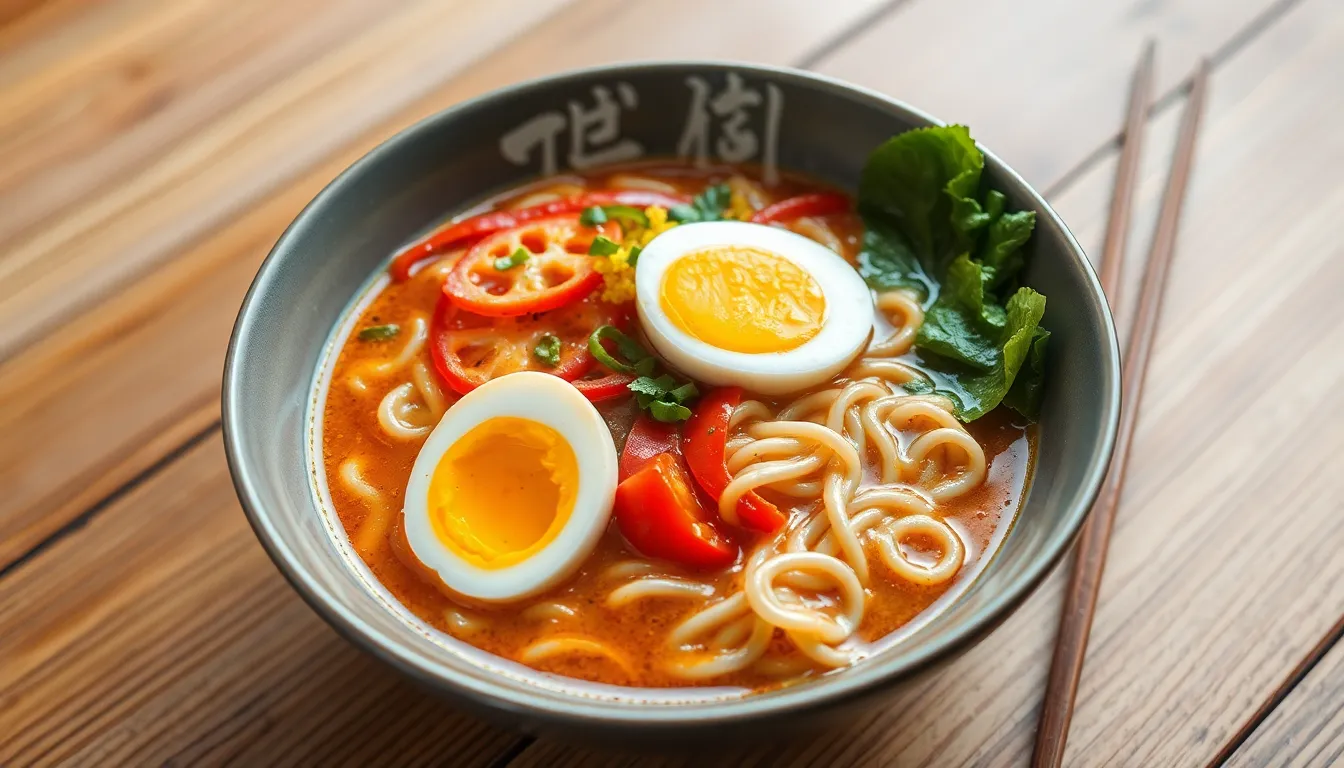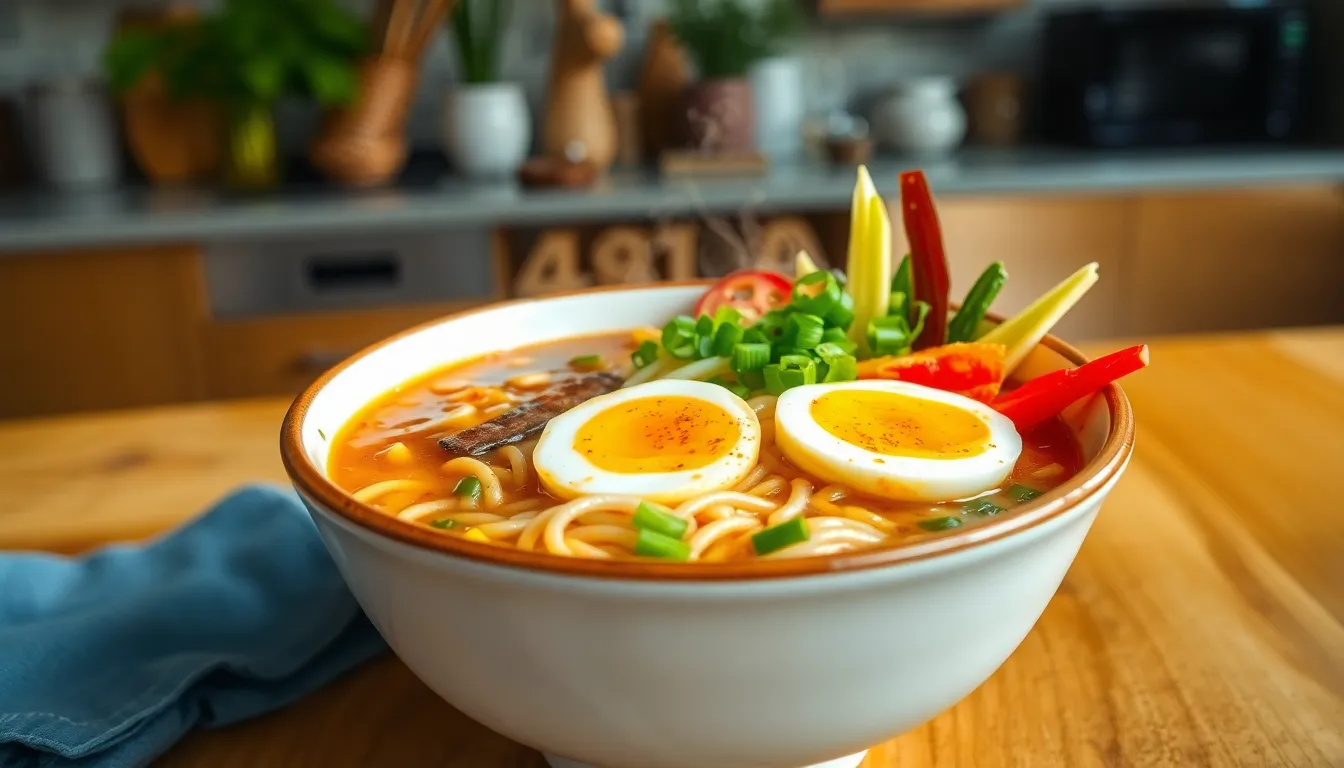Table of Contents
ToggleRamen noodles have become a staple in many diets, loved for their convenience and rich flavor. Whether enjoyed as a quick meal or a late-night snack, these noodles pack a punch in both taste and texture. But how do they fit into a balanced diet? The calorie count in ramen can vary significantly depending on the preparation method and additional ingredients.
Understanding the calorie content of ramen noodles is crucial for anyone looking to manage their weight or maintain a healthy lifestyle. With countless variations available, from instant ramen to gourmet versions, knowing the nutritional breakdown can help individuals make informed choices. Dive into the details to discover just how many calories are in your favorite ramen dish and what that means for your daily intake.
Overview of Ramen Noodles
Ramen noodles are a popular choice among individuals seeking a quick and satisfying meal. Commonly made from wheat flour, water, salt, and an alkaline mineral called kansui, these noodles provide a distinct texture and flavor. Ramen comes in various forms, including instant, fresh, and dried. Each type offers unique culinary opportunities and nutritional profiles.
The calorie content in ramen noodles can vary significantly. Instant ramen noodles typically contain approximately 380 to 500 calories per serving, depending on brand and preparation method. Fresh ramen noodles usually have a lower calorie count, averaging around 200 to 300 calories per serving. Dried ramen noodles can also range from 200 to 400 calories per serving, highlighting the differences among types.
Added ingredients can further influence calorie counts. Broths, vegetables, proteins, and toppings like eggs or meat contribute additional calories. For example, a simple vegetable broth might add another 50–100 calories, while a rich pork broth can increase the total calorie count by 200 calories or more.
Understanding these variations allows individuals to make informed choices when incorporating ramen noodles into their diets. Awareness of preparation methods and additional toppings plays a key role in managing overall calorie intake.
Caloric Content of Ramen Noodles


Understanding the caloric content of ramen noodles proves crucial for making informed dietary choices. The calorie count varies significantly across different types of ramen.
Instant Ramen Noodles
Instant ramen noodles commonly contain 380 to 500 calories per serving, depending on the brand and flavor. These noodles often include seasoning packets that can add additional calories. For example, flavored packets can range from 100 to 200 calories. Individuals often consume instant ramen as a quick meal or snack, making it the most popular choice among consumers.
Fresh Ramen Noodles
Fresh ramen noodles typically offer a lower caloric count, averaging 200 to 300 calories per serving. These noodles, made from a blend of wheat flour and water, provide a more authentic taste and texture compared to their instant counterparts. Fresh ramen does not usually include additional seasoning, thus keeping the caloric content lower. The addition of broth, vegetables, or proteins can enhance the nutritional value while influencing the total calorie count.
Nutritional Breakdown
Understanding the nutritional content of ramen noodles helps make informed dietary choices. The analysis includes macronutrients and micronutrients in various types of ramen.
Macronutrients
Macronutrients are essential for energy and overall health. Ramen noodles primarily consist of carbohydrates, proteins, and fats.
- Carbohydrates: Ramen noodles contain approximately 60 to 80 grams of carbohydrates per serving, making them a significant source of energy. Instant varieties often have higher carbohydrate content due to processing.
- Proteins: Each serving of ramen typically has 7 to 12 grams of protein, depending on the type. Fresh ramen generally offers more protein compared to instant varieties.
- Fats: Ramen noodles contain around 14 to 20 grams of fat per serving, primarily due to the oils included in flavor packets. Instant ramen usually has higher fat content because of frying during preparation.
Micronutrients
Micronutrients, including vitamins and minerals, contribute to overall health.
- Sodium: Instant ramen can be high in sodium, with levels reaching 700 to 1,500 milligrams per serving due to seasoning packets. Excess sodium intake may lead to health issues.
- Iron: Ramen noodles typically provide 1 to 4 milligrams of iron, essential for transporting oxygen in the blood. Fresh types may offer higher iron levels.
- B Vitamins: Ramen contains B vitamins, particularly niacin and thiamine, which support energy metabolism. Instant varieties often lack adequate levels of these vitamins unless fortified.
- Calcium: Some ramen options include small amounts of calcium, important for bone health, typically ranging from 1 to 50 milligrams per serving.
Awareness of these nutritional aspects enables better meal planning and choices when incorporating ramen into a diet.
Health Considerations
Ramen noodles can affect overall health due to their nutritional content and preparation methods. Understanding these factors contributes to making informed dietary choices.
Impact on Diet
Ramen noodles primarily consist of carbohydrates, which can contribute to energy intake. Instant varieties, with higher calorie and sodium levels, may lead to excessive calorie consumption if eaten frequently. Considering the higher sodium content in instant ramen, which ranges from 700 to 1,500 milligrams per serving, individuals with hypertension or cardiovascular concerns should monitor their intake. The protein content, typically 7 to 12 grams per serving, falls short of daily protein needs for many. Consulting a healthcare professional or nutritionist about incorporating ramen into a balanced diet is advisable.
Alternatives to Ramen Noodles
Several healthier alternatives exist for those looking to replace traditional ramen. Options include:
- Whole grain noodles: These offer higher fiber content and greater satiety.
- Zucchini noodles: Low in calories and carbs, these provide a vegetable-based substitute.
- Shirataki noodles: Made from konjac yam, they are very low in calories and carbs.
- Rice noodles: Gluten-free options that are lower in fat and can fit various dietary needs.
By replacing traditional ramen noodles with healthier alternatives, individuals can enjoy similar textures while benefiting from improved nutritional profiles. Choosing these substitutes promotes a balanced diet and supports better health outcomes.
Ramen noodles serve as a versatile and beloved meal option for many. With varying calorie counts and nutritional profiles, it’s crucial for individuals to choose wisely based on their dietary needs. Whether opting for instant, fresh, or dried varieties, understanding how additional ingredients affect caloric intake can lead to healthier choices.
For those mindful of their health, exploring alternatives like whole grain or vegetable-based noodles can provide a satisfying experience without compromising nutrition. By being informed about the calorie content and nutritional aspects of ramen, individuals can enjoy this popular dish while maintaining a balanced diet.







